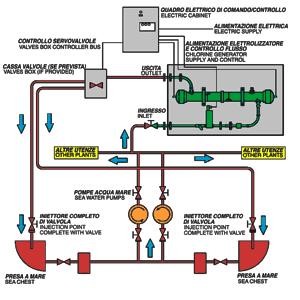
SANI CHLOR on board sewater antifouling system
Introductions and aims The on board antifouling treatment is carried out with the following aims: Cleaning of the sea chests by leading chlorinated discharge water through these. Elimination and prevention of biological mud ormation inside refrigerants and condensers in which seawater circulate.
Technical features
Introductions and aims
The on board antifouling treatment is carried out with the following aims:
- Cleaning of the sea chests by leading chlorinated discharge water through these.
- Elimination and prevention of biological mud ormation inside refrigerants and condensers in which seawater circulate.
- Deodorization and disinfection of the sanitary services. The antifouling treatment eliminates also putrefaction (causes horrible smells) that occurs in the sanitary pipes especially on old ships.
- Prevention and elimination of mussels (shells etc.), barnacles, seaweed etc. formation in the pipes where seawater passes, in particular in narrow passages.
The antifouling treatment serves to maintain clean for instance:
- Cooling engine circuits, condensers, generators, refrigerators, fire control etc.
- Location of anti roll fins.
- Cooling system of the shaft line supports etc..
Plant description
The main parts of the plant are as follows.
Electrical cabinet: supply the electrolyzer by direct current, receives alarm signals from the peripheral parts of the plant and control, if necessary, the distribution of the solution in the different parts of the plant.
Chlorine generator: here the production of NaOCl from the seawater occurs.
It is furthermore equipped with filters for the impurities and a flow sensor in case of lack of seawater supply.
Valve box (optional): provides the
distribution of the solution in the different sea chests and can be manually or
automatically controlled.
Injection point complete with valve:
Lets in the solution in the sea chest and is equipped with a security valve manually controlled (Device approved by the main Classification Societies).
Operation principals
The electrolysis of the seawater can be written as follows:
the complete reaction 2 NaCl + H2O --> NaOCl + NaCl + H2 describes how the solution salt + water, of which seawater is composed of, produces ipochlorite, salt and hydrogen through a simple electrolytic process continually nourished by the passage of the current through the electrolyzer.
The antifouling properties are guaranteed by the sodium ipochlorite leaving the electrolyzer while the continuous water flow and the low concentration of ipochlorite allow to reduce the hydrogen concentration and the high aggressiveness properties of the solution.
It´s also interesting to note that when the electrolysis has taken place the solution reverts to salt and water within 10 - 20 minutes.
Furthermore the plant ensures periodical cycles of automatic cleaning to protect the anodes from the encrustations and extend the duration up to 2 years at work.



